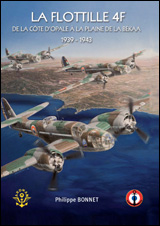Text : Fr
By Philippe Bonnet 304 pages with 280 photographs including 16 page colour booklet. 30.5 x 22 cm The F1A, 8F and 4F squadrons are heirs to the traditions of the Béarn squadron, itself a product of the Aviation d'Escadre. This book describes their history and that of the AB2/2AB/6B and AB4/4AB/7B squadrons for the period from October 1938 to June 1943, when the sailors assigned to these formations were successively opposed to German, Italian, British and American forces. The first part relates the beginnings of the Wing Aviation created by decree in October 1918. The year 1928 saw the commissioning of the aircraft carrier Béarn, which was the home of the Navy's embarked aircraft until the start of the war. On October 1st 1938, the 7S1 became the AB2 and the Béarn flotilla became the F1A. In September 1939, the F1A and its three squadrons were disembarked to be based at Lanvéoc-Poulmic. After a few months training, the AB2 was sent on May 15th 1940 against the enemy in Holland. With the AB4, they fought at Berlaimont and Origny - Sainte-Benoà®te. Folded back to Querqueville after the losses suffered in battle, they are deployed to Hyères. Italy's entry into the war offered them the opportunity to be engaged one last time, but without further success. They were finally evacuated to North Africa when the armistice with Italy was signed. The second part deals with the actions of the 8F and 4F flotillas in North Africa and the Levant. Following the Royal Navy's aggression of 4th July 1940 against French ships anchored at Mers el-Kebir, tension between France and the United Kingdom continued to grow. From September onwards, the two formations bombarded Gibraltar, then were engaged on several occasions in March 1941 against a British naval force. In June and July 1941, for a month, the 4F flotilla was deployed in the Levant to confront the Allied forces in terrible battles. The Syrian campaign ended with disastrous results as many sailors lost their lives. On its return to Tafaraoui, which had meanwhile become Lartigue, the 4F squadron was equipped with the twin-engine Lioré and Olivier 451 bomber. On November 8th 1942, the day of the Anglo-American landing in North Africa, after some small skirmishes, the Americans took Lartigue, without causing any significant loss of life. The rallying to the Allies allowed some of the personnel of the 4F flotilla to leave in March 1943 for the United Kingdom, to be trained for the missions assigned to the Coastal Command, which they would do from the Senegalese bases of Ouakam and Bel Air. In Algeria, the situation of the 4F flotilla, initially intended to become a school group, was resolved by its dissolution on 1 June 1943. The third part, the result of patient research, is devoted to the appendices, which are particularly well documented.
Voir les caractéristiques techniques
| Country | |
|---|---|
| Brand | |
| Model | |
| Manufacturer | |
| Drivers | |
| Scale | |
| Materials | NC |
| Release | 04-06-2015 |

 FR
FR
 EN
EN